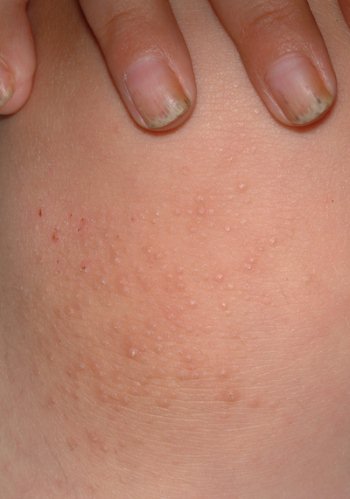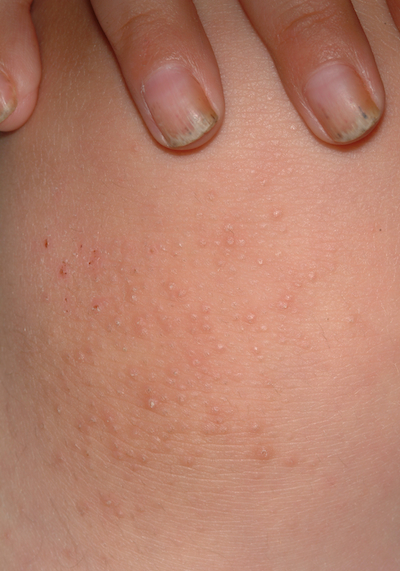User login

HISTORY
A 25-year-old man presents to dermatology with what he describes as a "fungal infection" of the fingernails that he's had since birth. His family physician made the diagnosis, noting similar changes in the nails of the patient's mother and several siblings.
The patient's family is part of a close-knit religious community of farmers whose northern European ancestors immigrated to this country several generations ago. For the most part, they keep to themselves, eschewing modern technology and marrying almost exclusively within the community.
EXAMINATION
The patient's fingernails are uniformly thickened and dystrophic, but without significant discoloration. All 10 toenails are similarly, though not as severely, affected. The patient's palms and soles are hyperkeratotic, and the upper anterior legs are covered by a folliculocentric papular hyperkeratosis reminiscent of a coarse keratosis pilaris.
DIAGNOSIS/DISCUSSION
This case of pachyonychia congenita (PC) is but one example of a large category of inheritable conditions involving skin, hair, and nails. These are sometimes referred to collectively as the "genodermatoses," a group that includes better-known entities such as neurofibromatosis, tuberous sclerosis, and Ehlers-Danlos syndrome.
PC is a rare condition that represents a mutation of keratin genes and is usually of autosomal dominant inheritance. First described by Muller in 1904, it was eventually categorized into one of two types: type I, MIM 167200, also known as Jadassohn-Lewandowsky, the most common type, and type II, MIM 167210, also known as Jackson-Lawler, with slightly different features. Today, a more common view is that no such divisions exist—only variations of PC that exhibit overlapping features.
PC appears to affect both genders equally and does not seem to have any effect on lifespan. However, when PC affects fingernails (87% of cases), there can be significant loss of function. In addition, the hyperkeratosis of palms and soles can be bothersome, even painful. In extreme cases, blisters can develop at the periphery of the hyperkeratotic areas. As these break down, the patient is subject to even more pain and the risk for secondary infection.
Cases such as this one mimic a significant item in the differential: epidermolysis bullosa. Patient education and reassurance serve well to assuage the patient's fears of fungal infection. A useful pearl for the clinician in that regard is that fungal infections of the fingernails are to be doubted, since they are quite uncommon.
A curious feature of this condition is that many children with PC are born with natal teeth, causing significant pain for the breastfeeding mother. These teeth are lost as permanent teeth grow in.
TREATMENT
The only treatment for PC is surgical ablation of the fingernails, a singularly impractical and unpredictable procedure. It is best reserved for the highly motivated patient.
TAKE-HOME LEARNING POINTS
• Pachyonychia congenita (PC) is a rare inherited mutation of keratin genes manifesting with thickened, dystrophic nails and hyperkeratosis of palms and soles.
• PC is only one of dozens of so-called "genodermatoses," inherited conditions involving skin, hair, nails, and mucous membranes; other examples include neurofibromatosis, tuberous sclerosis, and Ehlers-Danlos syndrome.
• A family history of similar problems, along with that of natal teeth, help to establish the diagnosis.
• Fungal infections of fingernails occur approximately 1/20 as often as onychomycosis of toenails.

HISTORY
A 25-year-old man presents to dermatology with what he describes as a "fungal infection" of the fingernails that he's had since birth. His family physician made the diagnosis, noting similar changes in the nails of the patient's mother and several siblings.
The patient's family is part of a close-knit religious community of farmers whose northern European ancestors immigrated to this country several generations ago. For the most part, they keep to themselves, eschewing modern technology and marrying almost exclusively within the community.
EXAMINATION
The patient's fingernails are uniformly thickened and dystrophic, but without significant discoloration. All 10 toenails are similarly, though not as severely, affected. The patient's palms and soles are hyperkeratotic, and the upper anterior legs are covered by a folliculocentric papular hyperkeratosis reminiscent of a coarse keratosis pilaris.
DIAGNOSIS/DISCUSSION
This case of pachyonychia congenita (PC) is but one example of a large category of inheritable conditions involving skin, hair, and nails. These are sometimes referred to collectively as the "genodermatoses," a group that includes better-known entities such as neurofibromatosis, tuberous sclerosis, and Ehlers-Danlos syndrome.
PC is a rare condition that represents a mutation of keratin genes and is usually of autosomal dominant inheritance. First described by Muller in 1904, it was eventually categorized into one of two types: type I, MIM 167200, also known as Jadassohn-Lewandowsky, the most common type, and type II, MIM 167210, also known as Jackson-Lawler, with slightly different features. Today, a more common view is that no such divisions exist—only variations of PC that exhibit overlapping features.
PC appears to affect both genders equally and does not seem to have any effect on lifespan. However, when PC affects fingernails (87% of cases), there can be significant loss of function. In addition, the hyperkeratosis of palms and soles can be bothersome, even painful. In extreme cases, blisters can develop at the periphery of the hyperkeratotic areas. As these break down, the patient is subject to even more pain and the risk for secondary infection.
Cases such as this one mimic a significant item in the differential: epidermolysis bullosa. Patient education and reassurance serve well to assuage the patient's fears of fungal infection. A useful pearl for the clinician in that regard is that fungal infections of the fingernails are to be doubted, since they are quite uncommon.
A curious feature of this condition is that many children with PC are born with natal teeth, causing significant pain for the breastfeeding mother. These teeth are lost as permanent teeth grow in.
TREATMENT
The only treatment for PC is surgical ablation of the fingernails, a singularly impractical and unpredictable procedure. It is best reserved for the highly motivated patient.
TAKE-HOME LEARNING POINTS
• Pachyonychia congenita (PC) is a rare inherited mutation of keratin genes manifesting with thickened, dystrophic nails and hyperkeratosis of palms and soles.
• PC is only one of dozens of so-called "genodermatoses," inherited conditions involving skin, hair, nails, and mucous membranes; other examples include neurofibromatosis, tuberous sclerosis, and Ehlers-Danlos syndrome.
• A family history of similar problems, along with that of natal teeth, help to establish the diagnosis.
• Fungal infections of fingernails occur approximately 1/20 as often as onychomycosis of toenails.

HISTORY
A 25-year-old man presents to dermatology with what he describes as a "fungal infection" of the fingernails that he's had since birth. His family physician made the diagnosis, noting similar changes in the nails of the patient's mother and several siblings.
The patient's family is part of a close-knit religious community of farmers whose northern European ancestors immigrated to this country several generations ago. For the most part, they keep to themselves, eschewing modern technology and marrying almost exclusively within the community.
EXAMINATION
The patient's fingernails are uniformly thickened and dystrophic, but without significant discoloration. All 10 toenails are similarly, though not as severely, affected. The patient's palms and soles are hyperkeratotic, and the upper anterior legs are covered by a folliculocentric papular hyperkeratosis reminiscent of a coarse keratosis pilaris.
DIAGNOSIS/DISCUSSION
This case of pachyonychia congenita (PC) is but one example of a large category of inheritable conditions involving skin, hair, and nails. These are sometimes referred to collectively as the "genodermatoses," a group that includes better-known entities such as neurofibromatosis, tuberous sclerosis, and Ehlers-Danlos syndrome.
PC is a rare condition that represents a mutation of keratin genes and is usually of autosomal dominant inheritance. First described by Muller in 1904, it was eventually categorized into one of two types: type I, MIM 167200, also known as Jadassohn-Lewandowsky, the most common type, and type II, MIM 167210, also known as Jackson-Lawler, with slightly different features. Today, a more common view is that no such divisions exist—only variations of PC that exhibit overlapping features.
PC appears to affect both genders equally and does not seem to have any effect on lifespan. However, when PC affects fingernails (87% of cases), there can be significant loss of function. In addition, the hyperkeratosis of palms and soles can be bothersome, even painful. In extreme cases, blisters can develop at the periphery of the hyperkeratotic areas. As these break down, the patient is subject to even more pain and the risk for secondary infection.
Cases such as this one mimic a significant item in the differential: epidermolysis bullosa. Patient education and reassurance serve well to assuage the patient's fears of fungal infection. A useful pearl for the clinician in that regard is that fungal infections of the fingernails are to be doubted, since they are quite uncommon.
A curious feature of this condition is that many children with PC are born with natal teeth, causing significant pain for the breastfeeding mother. These teeth are lost as permanent teeth grow in.
TREATMENT
The only treatment for PC is surgical ablation of the fingernails, a singularly impractical and unpredictable procedure. It is best reserved for the highly motivated patient.
TAKE-HOME LEARNING POINTS
• Pachyonychia congenita (PC) is a rare inherited mutation of keratin genes manifesting with thickened, dystrophic nails and hyperkeratosis of palms and soles.
• PC is only one of dozens of so-called "genodermatoses," inherited conditions involving skin, hair, nails, and mucous membranes; other examples include neurofibromatosis, tuberous sclerosis, and Ehlers-Danlos syndrome.
• A family history of similar problems, along with that of natal teeth, help to establish the diagnosis.
• Fungal infections of fingernails occur approximately 1/20 as often as onychomycosis of toenails.
